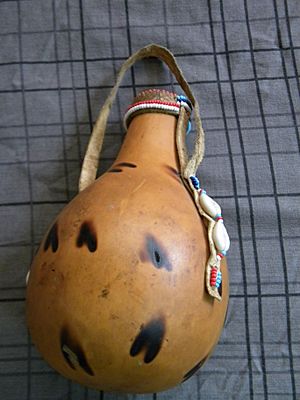Mursik facts for kids

Gourd used to make mursik
|
|
| Alternative names | Maziwa lala (Swahili) |
|---|---|
| Type | Milk |
| Course | Drink |
| Place of origin | Kenya |
| Region or state | Rift Valley |
| Cooking time | |
| Serving temperature | Room temperature |
| Main ingredients | Milk |
| Ingredients generally used | Soot (optional), cow blood (optional) |
| Similar dishes | Yogurt, sour milk |
Mursik is a special traditional drink from the Kalenjin people in Kenya. It's a type of fermented milk, a bit like yogurt or sour milk. People usually make it from cow or goat milk.
The milk is fermented inside a special container called a calabash gourd. This gourd is known as a sotet. Before using it, the inside of the gourd is lined with a special kind of soot. This soot comes from certain trees, like the African senna tree. The soot helps to give mursik its unique flavor. People often drink mursik with ugali, which is a thick porridge, or they drink it by itself. It can be served warm or cold.
Contents
Mursik's Role in Culture
Mursik is more than just a drink for the Kalenjin people. It's a very important part of their culture and identity. You can find this drink all over the Rift Valley area. It's also popular in cities across Kenya.
Mursik and Kenyan Athletes
Mursik has become a symbol for Kenyan athletes. Many famous Kenyan runners are Kalenjin. When these heroes return home from international competitions, they are often greeted with a sip of mursik. This tradition shows how proud people are of their athletes. It has become a well-known part of Kenya's culture.
Mursik in Weddings
Mursik also plays a key role in Kalenjin wedding traditions. During the koito ceremony, families discuss the dowry for the couple. After these discussions are finished, mursik is served to everyone present. Drinking mursik together at this moment is a symbol of agreement and unity. It shows that everyone accepts the terms and is happy.
How Mursik is Made
Mursik is mostly made from cow's milk. Sometimes, goat's milk or even sheep's milk is used, but this is less common. The milk is fermented in special gourds. These gourds are prepared carefully before each use.
Preparing the Gourd
First, the inside of the gourd is treated with smoke and charcoal from certain trees. This process is very important. Fresh milk, or milk that has been boiled and then cooled, is poured into the prepared gourd. The gourd is then sealed and kept in a cool, dry place. The milk ferments naturally for at least three to five days. This happens because of tiny living things like bacteria, yeast, and mold.
Traditional Ingredients
In the past, some communities would add fresh blood from a cow to the milk. This was done before or after fermentation. However, this practice is very rare today. Scientists have found that a type of bacteria called Lactobacillus plantarum is very important in making mursik. Other bacteria like Leuconostoc mesenteroides and Enterococcus faecium are also involved.
Special Trees for Flavor
The smoke and charcoal from specific trees are key to making traditional mursik. Farmers use trees like Senna didymobotrya, Lippia kituiensis, Prunus africana, and Olea europaea ssp. africana.
Kalenjin women use a special charcoal called "osek" to coat the inside of the gourd. You can see gray lines from this charcoal when you pour the thick, sour milk. They also make a brush called sosiot from a cycad tree branch. This brush is used to clean the inside of the gourd. These brushes are very strong and can last for up to two years.
The "osek" charcoal comes from the Ite or Itet tree, also known as peanut butter cassia. This charcoal helps to preserve the milk. It lines the gourd, making it airtight. The smoke also stops bad bacteria from growing, which prevents the milk from spoiling. At the same time, it allows the milk to sour naturally. The charcoal smoke also gives the milk a special flavor and a bluish color, which people enjoy.
After preparing the gourd, the women boil the milk to pasteurize it. This kills any harmful germs. The milk is then cooled before being poured into the gourd. Finally, the gourd is sealed tightly. This keeps the milk fresh for up to a month.
Different Kinds of Mursik
Mursik can have different flavors. This depends on how it's made and the quality of the milk. Many trees can be used to give the milk its special flavor and help preserve it. The bark of these trees usually has a lot of tannin. Popular trees include sertwet (acacia) and Cheblayat (wattle tree). Cheblayat is used most often because it's easy to find.
One way to make mursik is to fill a gourd with milk and seal it all at once. Another way is to add a little milk every few days. The fermented milk already in the gourd helps the new milk to ferment faster. Once the gourd is full, it's sealed for a while. This creates a clear, sharp liquid with white butter pieces floating in it. Another type of mursik ferments quickly and has a white, porridge-like texture.
Rotik: A Special Variant
There is a rare type of mursik called rotik. This variant traditionally included a small amount of cow blood mixed with the milk before fermentation. It has a slightly pink color. This type of mursik is not common anymore because drawing blood from cattle is rarely practiced. People believed that rotik was rich in iron and protein. It was traditionally given to women who had just given birth or to warriors who were injured in battle to help them recover.

